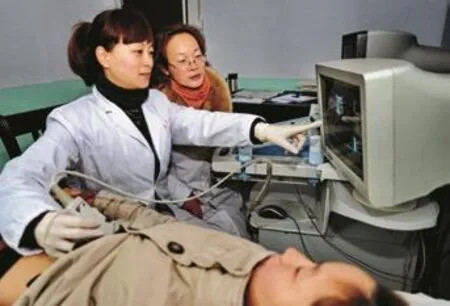Improving Care for All
2012-09-12LiLi
Improving Care for All
Despite remarkable progress China made in streamlining its healthcare system, an acute lack of resources still troubles rural areas By Li Li
M ore than one year after surviving a traffic accident, 37-year-old Gu Fenli is still going through a slow recovery from traumatic brain injuries at a rehabilitation center. Her speech is only understandable to close family members and her eyes are blank most of the time. However, her husband and father of two Wang Jiangang feels blessed. The farmer from Taicang in east China’s Jiangsu Province has been satisfied with the medical care his wife has received and the fact that it is affordable for his family.
The car crash that caused severe brain damage to Gu also left Wang with a broken collarbone. But knowing that his wife’s recovery depended on several complicated and expensive brain surgeries, Wang checked himself out of the hospital prematurely to fnd a job as a driver.
The following three brain surgeries cost a total of 328,500 yuan ($52,100). While the rebate from the state-sponsored social health insurance was 209,000 yuan ($33,200), the family still paid nearly 120,000 yuan ($19,000), an enormous burden to the couple who spent a fortune in treating the kidney illness of their son a few years ago.
One day last December, when Wang was worried about where to get the money for a badly needed surgery to repair his wife’s skull, he received a phone call from the local health insurance offce. He was informed that his wife was entitled to new insurance reimbursements totaling 79,800 yuan ($12,700).
“This is life-saving money,” said Wang. One of China’s top specialists in the feld successfully performed surgery on Gu, and all she needs for now is recovery.
The pilot program for alleviating financial burdens for people with conditions requiring lengthy and expensive medical treatment, introduced by Taicang in July 2011, has benefted 2,604 people in its frst year of operation.
With the absolute majority of China’s population covered by the health insurance system, the Central Government is focusing on offering special help to people requiring lengthy and expensive hospitalization.

ELITE EXAMINERS: Lu Kejian (left), a sonographer from a hospital in Jian’ou, Fujian Province, gives hands-on training to a colleague at a township hospital
As a new step to prevent patients from being reduced to poverty by necessary healthcare costs, the Central Government released a plan to increase health insurance rebates for people with critical illnesses under the country’s nearly universal health insurance system on August 30.
The fresh systematic arrangement will further increase the level of protection that China’s health insurance system can offer, according to an official document co-issued by the National Development and Reform Commission (NDRC) and fve other Central Government departments.
Those covered by China’s health insurance system will be entitled to reimbursements from the newly launched “major illness scheme” when their annual medical bill exceeds the local annual per-capita net income to ensure that everyone pays less than half of his or her total medical care costs. People don’t have to pay extra premiums for the new type of scheme as it will be paid by the balance of current insurance funds.
Sun Zhigang, head of the health reform offce under the State Council, China’s cabinet, said it aims to ensure that each patient’s total medical expenditure is no more than the “catastrophic household expenditure for healthcare.”
Though around 1.3 billion people, or more than 95 percent of China’s population, have been covered by the health insurance system by the end of last year, medical expenditure burdens in-curred by patients with severe medical conditions remain heavy, Sun said.
“The new move targets the widely complained problem of ‘people falling into poverty due to illnesses,’ and aims to ensure that most people won’t be reduced to poverty because of diseases,” Sun said.
Local governments have been asked to design regulations on fund raising, reimbursement portions and other details regarding the new insurance scheme in line with local conditions, according to the document.
Qualifed commercial insurers will bid to operate the critical illness insurance program, the document said.
Fruitful three years
Responding to the wide public complaints about unaffordable medical care and rural residents’ inability to enjoy quality medical services, the Central Government initiated a new round of reforms on China’s healthcare system in April 2009, including the goals of establishing a basic social health insurance system, implementing the essential medicine system and improving grassroots medical services.
According to a report submitted by the healthcare reform office under the State Council in June, all goals had been reached on schedule.
Between 2009 and 2011, the Central Government invested 450.6 billion yuan ($71.5 billion) in the country’s medical care services. The annual government subsidy for urban and rural residents’ insurance was increased from 80 yuan ($12.70) per person in 2008 to 240 yuan ($38.10) in 2012.
The government also invested 63 billion yuan ($10 billion) between 2009 and 2011 in the construction and improvement of 33,000 hospitals at local levels. Uneven distribution of medical resources between rural and urban areas had long been a subject of public criticism before the reform.
Furthermore, reform programs have been launched in over 2,000 public hospitals across the country, centering on separating these facilities’ medical services from pharmacy operations. China’s public hospitals have long been criticized for charging patients with excessive prices for medication. The hospitals often give doctors incentives to prescribe expensive and sometimes unnecessary medicines, a practice that has been sabotaging patients’ faith in the healthcare providers.
In an effort to curb the soaring drug prices, the government unveiled an essential drug list in 2009, which subsidizes 307 common Western and traditional Chinese medicines so that hospitals can sell them at the price of production costs. All essential medicines are listed by their generic names, and drug producers compete to supply essential medicines through public procurement.
Selling essential drugs at cost became compulsory in all community-level clinics in July 2011.
A major pilot reform on China’s large hospitals started in July, when all public hospitals in the southern boomtown of Shenzhen and one in Beijing began scrapping their drug markups. Under the new initiative, the markup is removed and the economic losses incurred will be covered by increasing medical consultation and service fees.
In the trial at Beijing Friendship Hospital, outpatients’ 5 yuan ($0.80) registration fee and up to 14 yuan ($2.20) consultation fee were replaced by a service fee ranging from 42 yuan ($6.70) to 100 yuan ($15.90), depending on the qualifcations of the physician. Meanwhile, the hospital has cut the 15-percent markup it charges on drugs.
Rural doctors shortage
China Youth Daily reported on August 13 that the Chinese countryside faces a shortage of 530,000 doctors.
According to a report on China’s medical resources released by the Ministry of Health, by the end of 2011 China had a total of 6.203 million health workers and only 1.126 million of them worked at China’s 66,000 rural clinics.
Meanwhile, Li Ling, an economics professor from Peking University who studied China’s healthcare reforms for years, told China Youth Daily that only 100,000 of China’s 600,000 annual medical school graduates will join the healthcare workforce.
“This indicates that despite a robust increase in the supply of medical school graduates, facilities in rural areas and at the communities still cannot find qualified staff. Almost no fresh graduates are willing to work in rural areas,” Li said.
According to a 2012 survey on medical school students conducted by Wang Hongman, a professor with the Institute of Medical Humanities of Peking University, less than 5 percent of respondents are willing to work at medical institutions at counties or townships and nearly 30 percent expect their starting annual incomes to be above 200,000 yuan ($31,700).
Zhu Zhixin, Vice Chairman of NDRC who supervised China’s healthcare reforms, said in December 2010 that because of the low salaries, limited career advancement opportunities and poor working conditions, rural and community clinics couldn’t recruit qualifed personnel and were suffering from a brain drain.
A doctor’s position in major hospitals in large cities has become so highly sought after that most of them require job candidates to have a doctoral degree. When medical school graduates cannot squeeze into facilities in large cities, instead of seeking jobs at facilities in counties or townships, many of them change their career directions to become pharmaceutical representatives, research assistants or teachers.
Li told China Youth Daily that rural medical facilities suffer from the most acute shortage in general practitioners. According to newspaper Health News, China has only around 80,000 certified general practitioners and there is a gap of at least 245,000 practitioners. Zhu Shanzhu, Dean of the School of Basic Medical Sciences at Fudan University, told Health News that in China general practitioners lag far behind specialists in terms of income, social status and career development opportunities.
Starting from 2010, the Central Government initiated a three-year program of providing every township clinic in China’s less-developed western areas with one medical school graduate in general practice. Selected high school graduates receiving free medical school education and living allowances they will serve at a designated facility for at least six years after graduation.
“Reformers should install career development paths for people working at rural and community medical facilities to ensure that they can obtain training opportunities and better benefts packages in the future,” Li told China Youth Daily.
lili@bjreview.com
